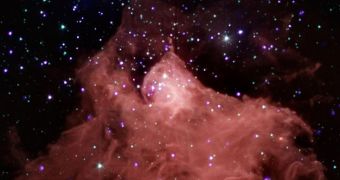The general feeling in the international astronomical community is that clearing up one of the last great mysteries of the Universe, how galaxies form, is now closer than ever. Studies and computer models are already beginning to provide the missing insight we lacked in this issue.
For example, the role of cosmic dust is beginning to become apparent. Though a nuisance when trying to view stars shrouded in their cocoons, or the cores of galaxies, without it there would be no stars to speak of, scientists now say.
Together with hydrogen gas, dust makes up the main ingredient for the collapse of huge cosmic clouds which ignite in the process and start nuclear fusion. The result is a protostar, which may continue to develop into a fully-fledged fireball.
Using a combination of new observations and supercomputer simulations, researchers are beginning to make sense of how dust and hydrogen interact to form huge galaxies, such as the ones that developed in the Universe shortly after the Big Bang.
“Formation of galaxies is one of the biggest remaining questions in astrophysics,” explains expert Andrey Kravtsov, who holds an appointment as an associate professor of astronomy and astrophysics at the University of Chicago.
Together with Fermi National Accelerator Laboratory (Fermilab) physicist Nick Gnedin, he developed a model explaining why stars tended to develop a lot slower in the early Universe than they do today.
“Gnedin and Kravtsov take a significant step in unifying these observations and simulations, and provide a prime illustration of the recent progress in the subject as a whole,” said expert Robert C. Kennicutt Jr.
He is the co-discoverer of the Kennicutt-Schmidt relation, one of the most important aspects detailing how stars form inside galaxies. He is the director of the Institute of Astronomy at the University of Cambridge, in the United Kingdom.
“What it shows is that at early stages of evolution, galaxies were much less efficient in converting their gas into stars,” Kravtsov says of the theory he developed from computer models with Gnedin.
“Early on, galaxies didn't have enough time to produce a lot of dust, and without dust it's very difficult to form these stellar nurseries,” he adds. Stellar nurseries are huge accumulations of gas and dust where new stars form at an accelerated pace.
Those galaxies did not “convert the gas as efficiently as galaxies today, which are already quite dusty,” the expert goes on to say.
The reason why dust is so important is that it facilitates the formation of hydrogen molecules from individual atoms inside stellar nurseries. They can be regarded as condensation nuclei for future stars.
Additionally, the dust also surrounds new stars, preventing their brutal solar winds from dispersing surrounding hydrogen gas accumulations, on their way of becoming stars themselves, SpaceRef reports.

 14 DAY TRIAL //
14 DAY TRIAL //